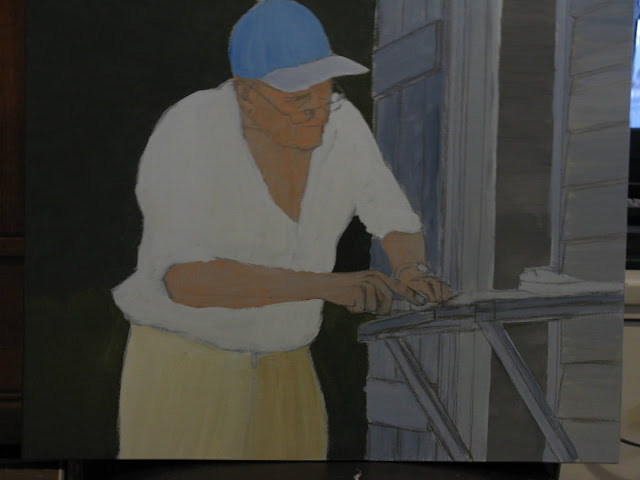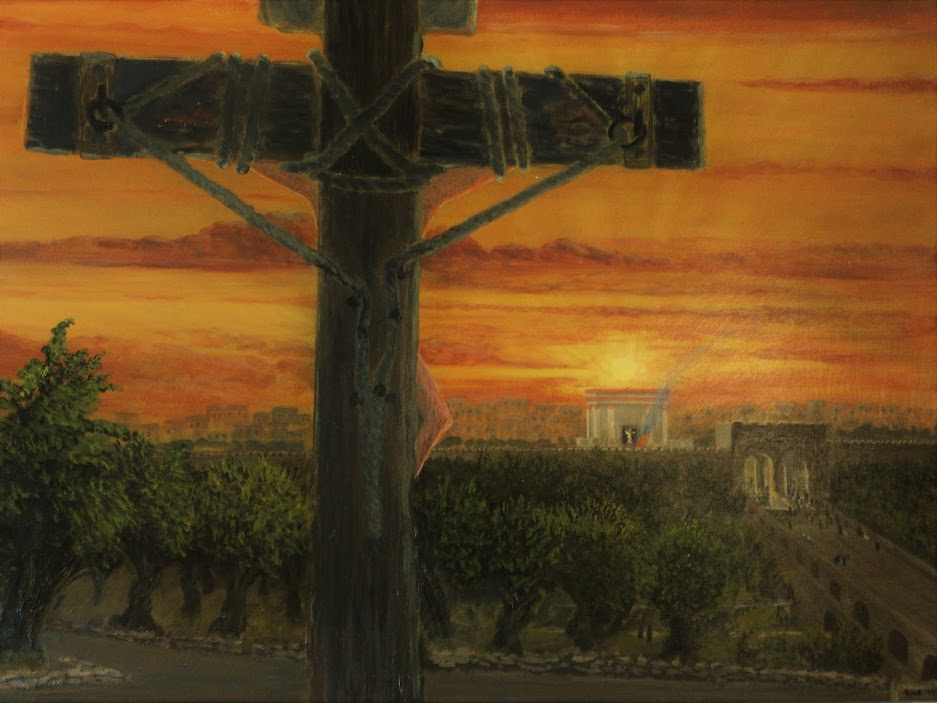Its hard to get a good image of this painting, so its presented in different camera settings .
I finally found the courage to post this. I have never shown this to the
public. It may be offensive to some people for different reasons. But, I
feel the time is right to post it. Its an acrylic on Hardboard panel
24" x 32"
I posted this on my painting demo blog, not just my painting site
because it explains the whole process that was needed to make this
painting . Its not a step by step of how the paint was applied to the
panel but it does get into the planning and research side of it. It took
hundreds of hours to plan it and perhaps less then 40 hrs to apply the
paint.
This painting has a long history attached to it. But, the story line
behind the subject material goes back thousands of years. I researched
the subject material for this work, off and on for more then 20 years,
with far too many days and hours invested into it, then I want to
disclose. I started the painting in 2010 after all the research, and
didn't finish it until 2017. It is based on Isaiah 1:11-13 'Bring no
more futile sacrifices'. Since the beginning of time man has been
offering up sacrifices to their gods. They would bring animals to their
temples and sacrifice them in ceremonial ritual, in hope these burnt
offering would appease their angry gods. They believed in a concept of a
god that was separate from them, and this separation theology caused
them to believe in what has been called substitutionary atonement. A
living being was sacrificed as a substitute for the tribe so they could
feel in right standing, at-one-ment, again with their distant and angry
deity. This idea carried over from ancient temple worship to modern
day Christianity where the Jesus character became the symbolic human
sacrifice, that would end all this futile sacrifices once and for all.
Progressive Christianity have rejected this idea,of any need for
atonement at all, and along with it, the old view of a vindictive and
angry tribal god, out there somewhere, that needs to be appeased. They
have realized a new way to view what the Divine is. Jesus spoke of the
kingdom of heaven within us. The divinity and realm
of heaven is found within our hearts, not at some remote location. The
loving intelligence that is at the matrix of all being is found within.
Modern Spirituality has come a long way and there has been a rethinking and appreciating the deep underlying truth in the old myths. Myths in this sense is not necessarily false, but
rather their symbolism brings out even greater truth, that have always
been there, but not easily realized. Parables tell stories that bring out great truth but we don't believe the characters are actual persons who lived in real life, myth is similar except they are more like embellished storied that are based on oral stories, passed on through multiple generations and then written down decades or centuries later. They bring out great truths like parables, and are not meant to be always seen an historical literal fact.This painting is all about
symbolism and myth and the power of myth to change lives. I won't get
into all that, here.
(detail section of the temple below with different camera settings and touch up on painting )


In this painting I have installed the Jewish holy temple which stood
on the temple mount in Jerusalem, before it was destroyed by the Romans
in 70CE.. The vantage point is looking westward from the slope of the
mount of olives, where some historians believe the Crucifixion of Jesus
took place 2000 years ago.
More info here This is the setting of the painting, based on
myth and reasoning of others, that I have researched. It is on a day when the animals were sacrificed and burnt offering were
made. The sun is setting in the west over the temple and the smoke of
the sacrifices are bellowing upward. I have Jesus on the
cross at the same time the animals were sacrificed just before
sunset. The eastern twin gates (Golden Gate) or the mercy gate, have been sealed up, off
and on since the 9th century and has remained that way since 1541.
click here Golden Gate
In this painting I have them open. Of these twin gates, the norther portal was called the gate of repentance, through which the repentant seeker of righteousness would have brought their sacrificial animals to the temple, the southern portal, also called the mercy gate, was where the repentant and forgiven walked out renewed by the mercy of God after they made atonement for their sins. (click here for more info on the
Mercy and repentance gates ) A causeway was said to have been
there, according to one source, that led from the eastern gates to the
mount of olives,it is believed to have intersected an old road that went
to Bethany. This is where Romans crucified criminals and enemies of the
empire, at a busy crossroad, so all would see. At the moment of
Jesus's death there was a myth that the temple curtain ripped in two
pieces and exposed the
Holy of Holies. That is why I have a white light shinning at the temple door opening,
with imagination you could say its in the shape of a divine presence
Shekhinah
leaving the temple.There is so much more symbolism but, I can't get into
it all, here. It would take many pages to explain.I have a huge stack
of research paper to back up my reasoning for this setting. Much of it
is controversy, including this painting, concerning details of location,
timing of events, and whether it all happen as we have been told. I will not judge the truth of it all.
This painting cannot be based on fact but it is more of a synthesis of
myth. The bottom line, is the fact that nobody really knows exactly
what happened so long ago. The painting is based on myth passed on to
our generation. I turned it all into a painting that tells a different
story then all other crucifixion paintings have done. Its totally
different then any other painting I have done. Its a dark subject about a
dark age that not everybody will appreciate, but its a story that needs
to be brought out.

I will add here also, other thoughts on design for this
painting. You will notice the rays of
the sun radiating outward from the sun center and upward I fanned the
original gesso brush strokes like that to create brush marks so the
final paint coats would follow in those grooves. The sun setting
directly over the temple is not uncommon in temple design and position,
what adds to this painting is that it is seen precisely directly over
the temple at the location of where the cross is placed, at the western
mid slop of the mount of olives. The temple is at the 1/3 horizontal and 1/3 vertical crossing
point and the cross is intentionally tilted toward the temple slightly.
The temple and sun are meant to be the main vocal point. The Moslem
dome of the rock temple sits at the Jewish temple site today. The olive
gardens were common at this location. If you look close there are
figures in the garden looking toward the cross. The cross is dark
because it is in shadow and I didn't want this image on the cross to be
the main point of interest.
The idea that the Jesus character was
looking toward the temple adds to the whole mythology because
Christianity later made the crucifixion symbolic of him being the final
sacrifice to supposedly end all ritual sacrifice. However, this
sacrifice, with symbols of wine (blood) and bread (body) are re-enacted
continually over and over again in Christian ritual, to this day. It
still proclaims a separation between us and God and it is only through
belief in this blood sacrifice of Jesus that we can have access to the
divine. It is just a remake of the old temple sacrificial system
rebranded to be more socially acceptable. People still need a priest and
an institution to have access to the holy presence in this system of
belief. The unity message of Jesus was completely misunderstood. Its hard to see the small figures
on the walkway through the eastern gates but they all have a lamb
following behind them. The whole sacrificial system of atonement was
barbaric by modern human standards. The sheep going to the slaughter is a
little side detail that is not easily seen on the digital small image
you are looking at on your screen. The smoke is the burnt offering
being offered in the fire in front of the holy of hollies. I mentioned
before the large
curtain that separated people from the supposed seat and presence of God
was ripped asunder the same moment Jesus died ,according to the legend.The white light where the dark curtain is split in the center of
the temple is symbolic of the spirit departing the earthly temple of
stone (hardened hearts) and the beginning of it residing in the open
spiritual hearts of the people. Or, put it this way, its symbolic in the
sense that with the ripping of the
veil of separation we now all have access to divinity. It resides in our
spiritual heart, the true holy of holies. Jesus was the one who pointed
to the new way, the new life and the new truth with his message of the
kingdom of heaven found within. It was his message of individual access
to the oneness of the divine Spirit, for all, that got him killed by the
religion of separation theology. His message of the kingdom of heaven
within all, did not fit well with both the Jewish and Roman system of
ideology. For the past 2000 years it still did not fit with the
ingrained idea of a separate god and the need for an institutional
religion of belief and ritual, to regulate our access to the divine. The
deeper story of Jesus is not about blood sacrifice, although we can
respect its symbolic effect, but, it is more about his message, the good
news, that removes the veil of separation between us and the divine.
His whole message in summary and the message in this painting, is the
proclamation that we all have access to the divine presence,
now, through the holy of holies found within our spiritual heart, it is
not found in temples of stone or through tablets of clay. The message is
loud and clear 'Bring no more futile sacrifices' on stone alters (with
hearts clenched), for the kingdom of heaven is found within, in a open
and pure spiritual heart, beyond the the veil of separation woven by a false sense of an egoic self and beyond body and blood. This illusion of a separate egoic self is the root cause of all our
perceptions of separation from others, nature and the divine presence.
But, you will have to do your own research on all that. The wisdom
teachings for thousands of years have been saying this, and now we have
the internet full of information on this subject.
“God is born in the Heart and the Heart is born in God,” - the great Christian mystic Meister Eckhart
Luke 17: 20-21 (the kingdom of heaven/God is found within you)
My painting site Here
My other blog Here
.JPG)
.JPG)

.JPG)
.JPG)





















.JPG)

.JPG)


.JPG)
.JPG)